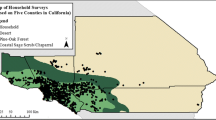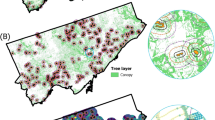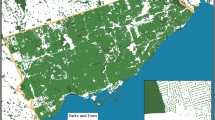Abstract
This paper presents a psychological perspective to the selection of trees for urban residential areas. Sixty tree species suitable for urban planting sites were rated by lay participants regarding preference. We then used outward tree features to predict the preference ratings. Twenty-five different plant characteristics served as possible predictors in a regression model for tree preference. We found that the distinction between conifers and deciduous trees, the maximum tree height, and the crown height-to-width ratio were valuable predictors for preference, explaining more than 70% of the variance. This adds support for evolutionary theories of landscape preference. The regression model presented in this paper can be applied to calculate a preference estimate for other tree species using their known physical data, which may facilitate tree selection tasks in green space planning. By specifying preference-relevant tree characteristics, our findings may also inform the process of selecting diverse species for sites where a homogenous overall appearance is a planning goal.



Similar content being viewed by others
References
Akaike H (1987) Factor analysis and AIC. Psychometrika 52(3):317–332
Autorengruppe Bildungsberichterstattung (2014) Bildung in Deutschland 2014. Ein indikatorengestützter Bericht mit einer Analyse zur Bildung von Menschen mit Behinderungen, Bertelsmann Stiftung, Bielefeld
Balling JD, Falk JH (1982) Development of visual preference for natural environments. Environ Behav 14(1):5–28
Bates D, Mächler M, Bolker BM, Walker SC (2014) lme4: fitting linear mixed-effects models using lme4. ArXiv. http://arxiv.org/abs/1406.5823
Belsley DA (1991) A guide to using the collinearity diagnostics. Comput Sci Econ Manag 4(1):33–50
Belsley DA, Kuh E, Welsch RE (1980) Regression diagnostics: identifying influential data and sources of collinearity. Wiley, New York
Berkowitz AR, Nilon CH, Hollweg KS (eds) (2003) Understanding urban ecosystems. Springer, New York
Berman MG, Jonides J, Kaplan S (2008) The cognitive benefits of interacting with nature. Psychol Sci 19(12):1207–1212
Bowler DE, Buyung-Ali LM, Knight TM, Pullin AS (2010) A systematic review of evidence for the added benefits to health of exposure to natural environments. BMC Public Health 10(1):456
Bréda NJJ (2003) Ground-based measurements of leaf area index: a review of methods, instruments and current controversies. J Exp Bot 54(392):2403–2417
Burns RM, Honkala BH (1990) Hardwoods. Agriculture handbook 654. No. 2 in Silvics of North America. U.S. Department of Agriculture, Forest Service, Washington, DC
Camacho-Cervantes M, Schondube JE, Castillo A, MacGregor-Fors I (2014) How do people perceive urban trees? Assessing likes and dislikes in relation to the trees of a city. Urban Ecosyst 17(3):761–773
Canty A, Ripley BD (2015) Boot: bootstrap R (S-plus) functions. R package version 1.1-9
Cekstere G, Nikodemus O, Osvalde A (2008) Toxic impact of the de-icing material to street greenery in Riga, Latvia. Urban For Urban Green 7(3):207–217
Chen JM, Rich PM, Gower ST, Norman JM, Plummer S (1997) Leaf area index of boreal forests: theory, techniques, and measurements. J Geophys Res 102(D24):29,429
Conway TM (2007) Impervious surface as an indicator of pH and specific conductance in the urbanizing coastal zone of New Jersey, USA. J Environ Manag 85(2):308–316
Conway TM, Urbani L (2007) Variations in municipal urban forestry policies: a case study of Toronto, Canada. Urban For Urban Green 6(3):181–192
Davison AC, Hinkley DV (1997) Bootstrap methods and their applications. Cambridge University Press, Cambridge
Donovan GH, Butry DT, Michael YL, Prestemon JP, Liebhold AM, Gatziolis D, Mao MY (2013) The relationship between trees and human health. Am J Prev Med 44(2):139–145
Euostat (2013) Rural development statistics by urban–rural typology. Online resource, Eurostat. http://ec.europa.eu/eurostat/statistics-explained/index.php/Rural_development_statistics_by_urban-rural_typology
Falk JH, Balling JD (2009) Evolutionary influence on human landscape preference. Environ Behav 42(4):479–493
Fraver S, D’Amato AW, Bradford JB, Jonsson BG, Jönsson M, Esseen PA (2013) Tree growth and competition in an old-growth Picea abies forest of boreal Sweden: influence of tree spatial patterning. J Veg Sci 25(2):374–385
Gerstenberg T, Hofmann M (2016) Perception and preference of trees: a psychological contribution to tree species selection in urban areas. Urban For Urban Green 15:103–111
Gillner S, Bräuning A, Roloff A (2014) Dendrochronological analysis of urban trees: climatic response and impact of drought on frequently used tree species. Trees 28(4):1079–1093
Gillner S, Vogt J, Tharang A, Dettmann S, Roloff A (2015) Role of street trees in mitigating effects of heat and drought at highly sealed urban sites. Landsc Urban Plan 143:33–42
Ginau A, Opp C, Sun Z, Halik Ü (2013) Influence of sediment, soil, and micro-relief conditions on vitality of Populus euphratica stands in the lower Tarim riparian ecosystem. Quat Int 311:146–154
Gundersen VS, Frivold LH (2008) Public preferences for forest structures: a review of quantitative surveys from Finland, Norway and Sweden. Urban For Urban Green 7(4):241–258
Gómez-Baggethun E, Barton DN (2013) Classifying and valuing ecosystem services for urban planning. Ecol Econ 86:235–245
Hägerhäll CM, Ode Å, Tveit MS, Velarde MD, Colfer CJP, Sarjala T (2010) Forests, human health and well-being in light of climate change and urbanisation. In: Mery G, Katila P, Galloway G, Alfaro RI, Kanninen M, Lobovikov M, Varjo J (eds) Forests and society: responding to global drivers of change, IUFRO world series, chapter 12, vol 25. International Union of Forestry Research Organizations, Wien, pp 223–234
Haluza D, Schönbauer R, Cervinka R (2014) Green perspectives for public health: a narrative review on the physiological effects of experiencing outdoor nature. Int J Environ Res Public Health 11(5):5445–5461
Hartig T, Evans G, Jamner L, Davis D, Gärling T (2003) Tracking restoration in natural and urban field settings. J Environ Psychol 23(2):109–123
Hartig T, Mitchell R, de Vries S, Frumkin H (2014) Nature and health. Annu Rev Public Health 35(1):207–228
Hofmann M, Westermann JR, Kowarik I, van der Meer E (2012) Perceptions of parks and urban derelict land by landscape planners and residents. Urban For Urban Green 11(3):303–312
Honold J, Lakes T, Beyer R, van der Meer E (2015) Restoration in urban spaces: nature views from home, greenways, and public parks. Environ Behav 48(6):796–825
IPCC (2014) Climate change 2014. Synthesis report, United Nations Intergovernmental Panel on Climate Change, Genève
James P, Tzoulas K, Adams M, Barber A, Box J, Breuste J, Elmqvist T, Frith M, Gordon C, Greening K, Handley J, Haworth S, Kazmierczak A, Johnston M, Korpela K, Moretti M, Niemelä J, Pauleit S, Roe M, Sadler J, Thompson CW (2009) Towards an integrated understanding of green space in the European built environment. Urban For Urban Green 8(2):65–75
Jo HK, Ahn TW (2012) Landscape preferences for greenspace structures. J For Sci 28(1):56–62
Johnson A (1995) The good, the bad and the ugly: science, aesthetics and environmental assessment. Biodivers Conserv V 4(7):758–766
Jucker T, Bouriaud O, Avacaritei D, Dănilă I, Duduman G, Valladares F, Coomes DA (2014) Competition for light and water play contrasting roles in driving diversity–productivity relationships in Iberian forests. J Ecol 102(5):1202–1213
Keniger L, Gaston K, Irvine K, Fuller R (2013) What are the benefits of interacting with nature? Int J Environ Res Public Health 10(3):913–935
Koffka K (1922) Perception: an introduction to the Gestalt-Theorie. Psychol Bull 19(10):531–585
Kuo FE, Sullivan WC (2001) Environment and crime in the inner city. Environ Behav 33(3):343–367
Lohr VI, Pearson-Mims CH (2006) Responses to scenes with spreading, rounded, and conical tree forms. Environ Behav 38(5):667–688
Maas J, Verheij RA, Groenewegen PP, de Vries S, Spreeuwenberg P (2006) Green space, urbanity, and health: how strong is the relation? J Epidemiol Community Health 60(7):587–592
Mitchell R, Popham F (2008) Effect of exposure to natural environment on health inequalities: an observational population study. Lancet 372(9650):1655–1660
Orians GH (2001) An evolutionary perspective on aesthetics. Bull Psychol Arts 2:25–29
R Core Team (2015) R: a language and environment for statistical computing. R Foundation for Statistical Computing, Wien
Radoglou K, Dobrowolska D, Spyroglou G, Nicolescu V (2009) A review on the ecology and silviculture of limes (Tilia cordata Mill., Tilia platyphyllos Scop. and Tilia tomentosa Moench.) in Europe. Die Bodenkult 60(3):9–19
Rambow R, Bromme R (1995) Implicit psychological concepts in architects’ knowledge: how large is a large room? Learn Instr 5(4):337–355
Säumel I, Weber F, Kowarik I (2016) Toward livable and healthy urban streets: roadside vegetation provides ecosystem services where people live and move. Environ Sci Policy 62:24–33
Schroeder H, Flannigan J, Coles R (2006) Residents’ attitudes toward street trees in the UK and US communities. Arboric Urban For 32(5):236–246
Sommer R (1997) Further cross-national studies of tree form preference. Ecol Psychol 9(2):153–160
Sommer R, Summit J (1995) An exploratory study of preferred tree form. Environ Behav 27(4):540–557
Sommer R, Summit J (1996) Cross-national rankings of tree shape. Ecol Psychol 8(4):327–341
Stamps AE III (2010) Use of static and dynamic media to simulate environments: a meta-analysis. Percept Mot Skills 111(2):355–364
Statistisches Bundesamt (2015) Bildungsstand der Bevölkerung. Technical report, Statistisches Bundesamt, Wiesbaden
Summit J, Sommer R (1999) Further studies of preferred tree shapes. Environ Behav 31(4):550–576
Sæbø A, Borzan Ž, Ducatillion C, Hatzistathis A, Lagerström T, Supuka J, García-Valdecantos JL, Rego F, Van Slycken J (2005) The selection of plant materials for street trees, park trees and urban woodland. In: Konijnendijk C, Nilsson K, Randrup T, Schipperijn J (eds) Urban forests and trees. Springer, Heidelberg, pp 257–280
Thomsen P, Bühler O, Kristoffersen P (2016) Diversity of street tree populations in larger Danish municipalities. Urban For Urban Green 15:200–210
Tinio PPL, Leder H (2009) Natural scenes are indeed preferred, but image quality might have the last word. Psychol Aesthet Creativity Arts 3(1):52–56
Todorovic D (2008) Gestalt principles. Scholarpedia 3(12):5345
United Nations (2014) World urbanization prospects: the 2014 revision. United Nations, Department of Economic and Social Affairs, Population Division, New York
Vogt J, Gillner S, Hofmann M, Tharang A, Dettmann S, Gerstenberg T, Schmidt C, Gebauer H, van de Riet K, Berger U, Roloff A (2017) Citree: a database supporting tree selection for urban areas in temperate climate. Lands Urban Plan 157:14–25
von Döhren P, Haase D (2015) Ecosystem disservices research: a review of the state of the art with a focus on cities. Ecol Ind 52:490–497
Wertheimer M (1923) Untersuchungen zur Lehre von der Gestalt. II. Psychol Res 4(1):301–350
Zensusdatenbank (2013) Zensus 2011. Online resource, Statistische Ämter des Bundes und der Länder. http://ergebnisse.zensus2011.de/
Zheng B, Zhang Y, Chen J (2011) Preference to home landscape: wildness or neatness? Landsc Urban Plan 99(1):1–8
Acknowledgements
We wish to thank Anna Neubauer, Joscha Möller, Anne Albinus, and Anne Neumeister for help with data acquisition. We are grateful to the anonymous reviewers for their time and their helpful comments and suggestions. Funding for this research was provided by the European Union and the Free State of Saxony (SAB Grant 100098207).
Author information
Authors and Affiliations
Corresponding author
Additional information
Communicated by Aaron R. Weiskittel.
Electronic supplementary material
Below is the link to the electronic supplementary material.
Appendices
Appendix 1: Sources of the photographs used in Fig. 1
The numbers in the bottom left corners were inserted for the study by the authors. Original image credits, from left to right:
- 1 :
-
Acer campestre 006 by Willow. Licensed under Creative Commons Attribution-Share Alike 2.5. Source: http://commons.wikimedia.org/wiki/File:Acer_campestre_006.jpg
- 34 :
-
Pedrengo cedro nel parco Frizzoni by Luigi Chiesa. Licensed under the Creative Commons Attribution-Share Alike 3.0 Unported. Source: http://commons.wikimedia.org/wiki/File:Pedrengo_cedro_nel_parco_Frizzoni.jpg.
- 10 :
-
Gleditsia triacanthos sunburst by Bostonian13. Licensed under Creative Commons Attribution-Share Alike 3.0. Source: http://commons.wikimedia.org/wiki/File:Gleditsia_triacanthos_sunburst.jpg
- 52 :
-
Quercus phellos by Daderot. Licensed under Creative Commons CC0 1.0 Universal Public Domain Dedication. Source: http://commons.wikimedia.org/wiki/File:Quercus_phellos_-_University_of_Kentucky_Arboretum_-_DSC09357.JPG
- 4 :
-
Betula pendula 001 by Willow. Licensed under Creative Commons Attribution 2.5. Source: http://commons.wikimedia.org/wiki/File:Betula_pendula_001.jpg
Appendix 2: Preference ratings per species
See Table 5.
Rights and permissions
About this article
Cite this article
Hofmann, M., Gerstenberg, T. & Gillner, S. Predicting tree preferences from visible tree characteristics. Eur J Forest Res 136, 421–432 (2017). https://doi.org/10.1007/s10342-017-1042-7
Received:
Revised:
Accepted:
Published:
Issue Date:
DOI: https://doi.org/10.1007/s10342-017-1042-7




